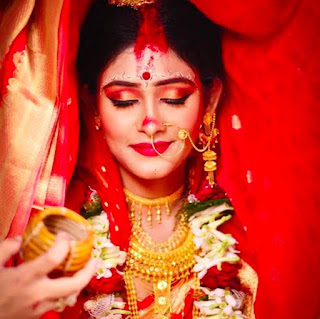What is significance of Bindi or Red Kumkum? Is Bindi necessary according to Vedas? What is Bindi made of? What are benefits of applying Bindi? INSIGHTS
Symbolism in Society
· Red is vibrant color
out of all colors. Suppose if you are in the forest, which is full of greens
but I bet you can easily spot the red blossoming flower or red fruits on the
tree or anything that is red because red is most vibrant of all. So, it was
easily spot-able. Thus, if a women wearing a red Kumkum or should we say Bindi
on her head, it means she is married and un-approachable. It was social
symbolization of who’s who and that’s why only unmarried women were not
supposed to wear Red Kumkum on her forehead until marriage.
What Bindi is made of originally?
Benefits Originally
Strengthen the concentration –
The area between brows where we commonly apply Kumkum is generally called as ‘Third eye’ which is also because in our Vedas, that area is represented by Ajna Chakra, which is responsible for concentration and concealed wisdom. Thus, pressing it three to four times a day can make your concentration concrete since it is also wired with Pineal gland which is light sensitive gland. It improves intuition and awareness in our consciousness. It boosts memory. That’s why your mom remembers all your mistakes, rewards and even your naughtiness when you were young, still very vividly.
Instant relaxation-
Helps with insomnia-
Massaging the discussed spot can also cause insomnia because it relaxes muscles of face, neck and back body. Trigeminal nerve also helps with to calm down your whole nervous system as we explained before. It helps with Depression, Epilepsy, and Post Traumatic Stress Disorder (PTSD) like clinical problem, which is proven as a fact.
Prevent Wrinkles-
Significance of 'Third Eye' in Vedas
According to Vedas, the spot between eyebrows is spiritually hollow (not physically since it has skull bone) because the breath (‘Pran’) or the living part of ours which we generally define as ‘Soul’ but in Hindu or Vedic culture define it as ‘Pran’. According to Vedic Scripts, ‘Pran’ comes in body through ‘Third eye’ and leave the body through ‘Third eye’ too (most of the time not every time). Thus, it a very crucial spot for spiritual awakening which leads to numerous mental health benefits to our, which now medically proven too and turmeric is boon for our body that have numerous health benefits but why red color only?
Red color is symbolism of Goddess Durga, fertility, prosperity, and a mark that you should respect the one who is Sindoor because red is Goddess color but mainly it is defined as ‘Married Symbol’ for society back in the time. Red symbolizes love, commitment, strength and bravery. Red is often connected to Maa Durga, a warrior goddess who symbolizes strength and power. The color holds the positive concepts for Hinduism and ceremony because brides wear red clothing, put red Sindoor in the center parting of their hairs, apply Bindi on forehead between brows.
The mantra that is usually employed for sindūr-dānam in North India weddings according to Sukla Yajur Veda is:–
vā̱mam a̱dya sa̍vitar vā̱mam u̱ śvo di̱ve di̍ve vā̱mam a̱smabhyagu̍ṁ sāvīḥ | vā̱masya̱ hi kṣaya̍sya deva̱ bhūre̍ra̱yā dhi̱yā vā̍ma̱ bhāja̍s syāma ||
Fair wealth O Savitar, today, tomorrow, fair wealth produce for us each day that passes. May we through this our song, O God, be happy gainers of a fair and spacious habitation. (Y.V. 8:6)
Conclusion
Red Kumkum on forehead for more like a symbols for society and rituals as mentioned in Manu Smriti with Mangal sutra but not in Vedas. Thus, I presume that it was more like a symbolism in the society and all the benefits were designed to encourage the use of the symbols so that men could ultimately know that who is ‘approachable’ and who is ‘not approachable’.
Dilution of Vedic practices (which include respect for girls and women) has probably led to more prominent display of symbols to tell men their limits, especially those symbols that have been part of rituals - these were/ are supposed to command respect. The more invasions by external forces, the more adulteration of culture and practices as well as stronger urge to protect the identity you believe in.
(These pictures have been taken from random sites from internet, if you want to take them down or remove them; contact us)
THANK YOU VERY MUCH FOR YOUR READING!!











Comments
Post a Comment